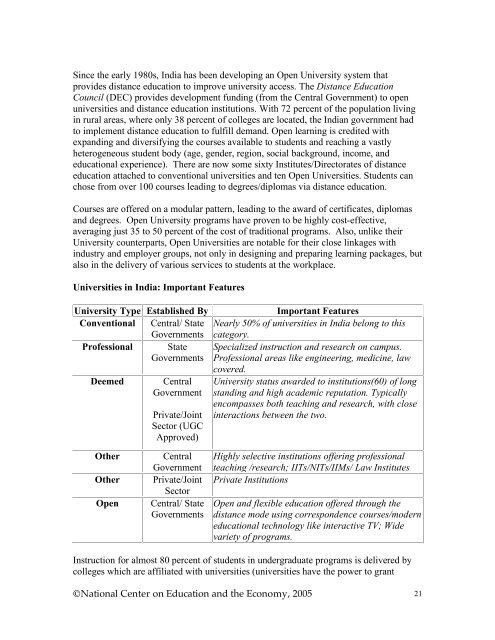India Education Report (2005) - NCEE
India Education Report (2005) - NCEE
India Education Report (2005) - NCEE
Create successful ePaper yourself
Turn your PDF publications into a flip-book with our unique Google optimized e-Paper software.
Since the early 1980s, <strong>India</strong> has been developing an Open University system that<br />
provides distance education to improve university access. The Distance <strong>Education</strong><br />
Council (DEC) provides development funding (from the Central Government) to open<br />
universities and distance education institutions. With 72 percent of the population living<br />
in rural areas, where only 38 percent of colleges are located, the <strong>India</strong>n government had<br />
to implement distance education to fulfill demand. Open learning is credited with<br />
expanding and diversifying the courses available to students and reaching a vastly<br />
heterogeneous student body (age, gender, region, social background, income, and<br />
educational experience). There are now some sixty Institutes/Directorates of distance<br />
education attached to conventional universities and ten Open Universities. Students can<br />
chose from over 100 courses leading to degrees/diplomas via distance education.<br />
Courses are offered on a modular pattern, leading to the award of certificates, diplomas<br />
and degrees. Open University programs have proven to be highly cost-effective,<br />
averaging just 35 to 50 percent of the cost of traditional programs. Also, unlike their<br />
University counterparts, Open Universities are notable for their close linkages with<br />
industry and employer groups, not only in designing and preparing learning packages, but<br />
also in the delivery of various services to students at the workplace.<br />
Universities in <strong>India</strong>: Important Features<br />
University Type Established By<br />
Conventional Central/ State<br />
Governments<br />
Professional State<br />
Governments<br />
Deemed<br />
Central<br />
Government<br />
Private/Joint<br />
Sector (UGC<br />
Approved)<br />
Important Features<br />
Nearly 50% of universities in <strong>India</strong> belong to this<br />
category.<br />
Specialized instruction and research on campus.<br />
Professional areas like engineering, medicine, law<br />
covered.<br />
University status awarded to institutions(60) of long<br />
standing and high academic reputation. Typically<br />
encompasses both teaching and research, with close<br />
interactions between the two.<br />
Other<br />
Other<br />
Open<br />
Central<br />
Government<br />
Private/Joint<br />
Sector<br />
Central/ State<br />
Governments<br />
Highly selective institutions offering professional<br />
teaching /research; IITs/NITs/IIMs/ Law Institutes<br />
Private Institutions<br />
Open and flexible education offered through the<br />
distance mode using correspondence courses/modern<br />
educational technology like interactive TV; Wide<br />
variety of programs.<br />
Instruction for almost 80 percent of students in undergraduate programs is delivered by<br />
colleges which are affiliated with universities (universities have the power to grant<br />
©National Center on <strong>Education</strong> and the Economy, <strong>2005</strong> 21


